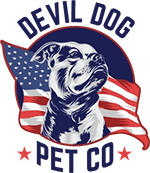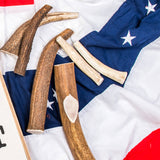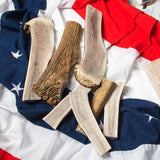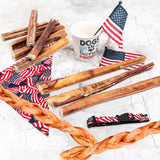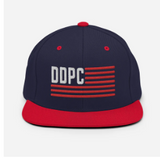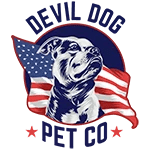Key Takeaways
- Safe elk antler chews are essential for aggressive dogs who destroy toys quickly.
- Choosing the wrong elk antler chew can lead to choking, splintering, or dental injuries.
- The right elk antler chew provides long-lasting enrichment and helps clean teeth.
- Elk antler chews also promote healthy jaw muscle exercise for power chewers.
Table of Contents
- Are Elk Antler Chews Truly Safe for Aggressive Dogs?
- Elk Antler Chews 101: What Makes Them Unique Among Dog Chews
- Why Aggressive Chewers Demand Special Attention (And How Antlers Fit In)
- Whole vs. Split Elk Antler Chews: Which is Right for Your Dog?
- Sizing Guide for Maximum Safety
- Elk Antler Chews vs. Other Popular Options
- Science-Backed Benefits of Elk Antler Chews
- How to Select the Safest Elk Antler Chew (Devil Dog Protocol)
- How to Introduce and Supervise Elk Antler Chews Safely
- How to Spot & Respond to Dental or Health Problems
- Best Practices for Cleaning, Storing, & Replacing Elk Antler Chews
- When Elk Antlers AREN'T the Answer, Smart Alternatives
- Devil Dog Pet Co. Pledge: Our Safety Standards and Sourcing Transparency
Safe Elk Antler Chews for Aggressive Dogs: The Devil Dog Pet Co. Field Guide
Power chewers who demolish toys in minutes need safe elk antler chews for aggressive dogs that won't splinter, choke, or break teeth. The wrong choice sends you to the emergency vet, the right one delivers weeks of safe enrichment while scraping plaque and exercising jaw muscles. MONSTER Whole Elk Antler Dog Chew is a top choice for dogs that need maximum durability, while the Jumbo - Split Elk Antler Dog Chew offers a flavorful option for those who prefer exposed marrow.
As a Marine Corps veteran who co-founded Devil Dog Pet Co. after watching our dog Dexter destroy everything from furniture to "indestructible" toys, I've learned that aggressive chewers demand premium-grade elk antlers, proper sizing, and owner supervision. Skip the guesswork, here's your complete field guide to safe antler selection, introduction, and monitoring. For a full range of options, explore our Premium Grade-A Elk Antler Dog Chews (Whole & Split Cuts) collection.
Are Elk Antler Chews Truly Safe for Aggressive Dogs?
Elk Antler Chews 101: What Makes Them Unique Among Dog Chews

Elk antler chews are naturally-shed antler segments from wild Rocky Mountain elk, collected each spring when bulls drop their racks. Unlike farmed deer whose antlers are sawn off, wild elk shed complete, mineral-rich antlers that retain full nutritional density and structural integrity.
Are elk chews safe for dogs compared to alternatives? Natural elk antlers contain zero artificial preservatives, bleaches, or chemical hardeners. Each piece delivers calcium (450mg per 100g), phosphorus (200mg per 100g), and trace minerals like zinc and magnesium, all while contributing virtually zero calories to your dog's daily intake. For a deeper dive into safety, see our guide on are antlers safe for dogs.
| Chew Type | Processing | Digestibility | Splintering Risk |
|---|---|---|---|
| Elk Antler | None (natural shed) | Mineral dust only | Very low |
| Rawhide | Chemical treatment | Poor | High |
| Synthetic Bones | Molded plastic/nylon | None | Medium |
Devil Dog Pet Co. sources exclusively from ethical shed hunters who traverse backcountry terrain each spring, ensuring our antlers come from healthy, free-range elk herds. Every piece is cut to precise specifications and inspected for density, freshness, and safety before packaging.
Why Aggressive Chewers Demand Special Attention (And How Antlers Fit In)
Aggressive chewers exhibit three key behaviors: destroying "tough" toys within 30 minutes, leaving deep bite marks in hard materials, and applying sustained jaw pressure during chewing sessions. These dogs generate 200-400 pounds of bite force, enough to crack inferior chews and create dangerous fragments.
Standard chews fail power-chewers catastrophically. Rawhide becomes choking-hazard mush, rope toys unravel into intestinal blockages, and plastic bones splinter into sharp shards. Even "extra-tough" rubber toys often surrender chunks that require surgical removal.
Are antlers good for dog chews for these extreme cases? Premium elk antlers match aggressive chewing intensity without compromising safety. Their dense outer cortex forces slow, methodical grinding that satisfies the chewing urge while preventing rapid consumption. The mineral-rich composition actually strengthens as dogs chew, unlike synthetic materials that weaken and fragment.
However, antlers aren't universal solutions. Dogs with previous dental work, senior pets with worn teeth, or animals recovering from oral surgery should avoid hard chews entirely. Always consult your veterinarian before introducing antlers to dogs with dental concerns or aggressive straight-down biting patterns.
Whole vs. Split Elk Antler Chews: Which is Right for Your Dog?
Whole elk antlers maintain their complete cylindrical structure, preserving maximum density and longevity. Split antlers are cut lengthwise to expose the nutrient-rich marrow core, offering immediate flavor reward for hesitant chewers or dogs transitioning from softer treats.
For aggressive chewers, whole antlers provide superior durability, a Monster-sized whole antler often entertains a 70-pound power-chewer for 3-5 weeks of regular sessions. Split antlers expose tasty marrow that motivates picky dogs but typically last 40-60% less time due to the softer exposed interior. If your dog prefers split options, consider the Large - Split Elk Antler Dog Chew - 1 Pack for a balanced introduction to antler chewing.
Whole Antlers - Best For Power Chewers
- Maximum longevity (weeks vs. days)
- Highest density prevents rapid consumption
- Most cost-effective per chewing hour
- Ideal for dogs who ignore unflavored chews
Split Antlers - Best For Beginners
- Immediate marrow flavor attracts reluctant chewers
- Gentler on teeth for puppies and seniors
- Shorter lifespan for aggressive chewers
- More mess (marrow crumbs)
Sizing Guide for Maximum Safety

Proper sizing prevents 95% of antler-related incidents. For aggressive chewers, the "size up" rule is non-negotiable, choose antlers one size larger than standard recommendations to account for powerful jaw mechanics and extended chewing sessions.
| Dog Weight | Standard Size | Aggressive Chewer Size | Length Minimum |
|---|---|---|---|
| 20-40 lbs | Medium | Large | 5-6 inches |
| 40-70 lbs | Large | XL | 6-7 inches |
| 70+ lbs | XL | Monster/Beast | 7-8 inches |
Split antlers work best for dogs new to antler chewing or seniors with moderate jaw strength. The exposed marrow provides immediate taste reward while requiring less force to access nutrients. Whole antlers suit established chewers who need maximum durability, our Beast-sized whole antlers have entertained 90-pound dogs for over a month of daily sessions.
Thickness matters as much as length. The antler should never fit between your dog's back molars, where crushing force concentrates. Devil Dog's Monster and Beast sizes maintain 2+ inch diameters specifically for large-breed power chewers who generate extreme bite pressure.
Elk Antler Chews vs. Other Popular Options
When evaluating safe elk antler chews for aggressive dogs against alternatives, four criteria determine real-world performance: safety profile, durability under extreme pressure, mess factor, and veterinary acceptance.
| Chew Type | Dental Safety | Lasts (Aggressive Dog) | Mess/Odor | Digestibility |
|---|---|---|---|---|
| Elk Antler | High (when sized correctly) | 3-5 weeks | None | Mineral dust only |
| Bully Stick | High | 20-45 minutes | Moderate odor | Fully digestible |
| Rawhide | Poor (choking risk) | 1-3 hours | Mess when wet | Very poor |
| Nylon Bones | Medium (wear risk) | 2-4 weeks | None | None (synthetic) |
Bully sticks offer complete digestibility and high palatability but vanish quickly under aggressive chewing, a 12-inch jumbo stick rarely survives 45 minutes with a determined 60-pound dog. The cost-per-hour heavily favors antlers for power chewers who need extended engagement. For a long-lasting, digestible option, try our 12" Ultra Thick Bully Stick - 3pk.
Rawhide poses the highest risk for aggressive chewers, becoming slippery and difficult to grip when wet, leading to gulping behaviors and potential blockages. Synthetic bones avoid digestibility concerns but can wear down teeth through prolonged grinding against artificial materials.
Are antlers safe chews for dogs compared to these alternatives? Premium elk antlers provide the optimal balance, harder than digestible chews but softer than synthetic materials, with natural mineral content that benefits rather than burdens the digestive system. For more on safe chew options, see our article on safe chews for dogs.
Science-Backed Benefits of Elk Antler Chews
Veterinary research supports three primary benefits of elk antler chews: mechanical plaque removal, jaw muscle strengthening, and mineral supplementation. A 2019 study in the Journal of Veterinary Dentistry found that dogs using natural antler chews showed 34% less plaque accumulation compared to those without regular chewing enrichment.
The abrasive action of antler surfaces scrapes soft plaque deposits while stimulating saliva production, nature's tooth cleaner. However, antlers cannot remove calcified tartar, which requires professional dental cleaning. The grinding motion also exercises jaw muscles and temporomandibular joints, maintaining oral health in active chewers.
Mineral absorption from antler chewing remains minimal, dogs ingest primarily calcium-phosphate dust rather than significant nutritional quantities. Are elk antlers safe for dogs to chew nutritionally? The trace mineral content poses no toxicity risk, but antlers should supplement, not replace, balanced nutrition. For a scientific perspective, read this PetMD article on antlers as dog chews.
Key Limitations
Not suitable for: Dogs with previous dental fractures, puppies under 4 months, seniors with worn teeth, or dogs who bite straight down with full force. Always supervise initial sessions to assess chewing style.
How to Select the Safest Elk Antler Chew (Devil Dog Protocol)

Our field-tested selection protocol eliminates dangerous antlers before they reach your dog. Start with the "jaw test", measure your dog's lower jaw from canine to canine, then choose an antler at least 2 inches longer. This prevents the antler from sliding back between molars where crushing force concentrates.
Grade-A antlers display uniform density, fresh coloration (cream to light brown), and zero surface cracks. Avoid gray, chalky, or lightweight pieces, indicators of age or poor storage that compromise structural integrity. Fresh antlers feel solid and produce a sharp "click" when tapped together.
For our dog Dexter, a 65-pound power chewer, we exclusively use Monster whole antlers, 7+ inches long and thick enough to prevent molar contact. The sizing provides 4-6 weeks of safe enrichment while maintaining the challenge level his jaw strength demands. If your dog is in the extra-large category, the Extra Large (XL) Whole Elk Antler Official Dog Chew is an excellent fit.
Devil Dog's quality control inspects every antler for weight consistency, surface integrity, and proper curing. We reject any piece showing stress fractures, excessive porosity, or dimensions outside our safety specifications. This veteran-level attention to detail ensures only the safest safe elk antler chews for aggressive dogs reach your home.
How to Introduce and Supervise Elk Antler Chews Safely
Leadership starts before the first chew session. Never hand over an antler and walk away, aggressive chewers require structured introduction and active supervision to establish safe chewing patterns.
Begin with a 15-minute supervised session. Hold one end of the antler while your dog explores the other, praising calm gnawing and redirecting any attempts to bite straight down with full force. This teaches proper technique while preventing dangerous crushing behaviors that can fracture teeth.
For dogs showing zero interest, rub a small amount of low-sodium bone broth or natural peanut butter into the antler's surface grooves. The scent activation often triggers investigation, but remove any added substances after 5 minutes to maintain the antler's natural properties.
First Week Protocol
Days 1-2: 15 minutes, supervised holding
Days 3-4: 20 minutes, supervised freedom
Days 5-7: 30 minutes, periodic check-ins
Week 2+: Extended sessions based on chewing style assessment
Store antlers in a dry, ventilated area between sessions. Avoid sealed containers that trap moisture and promote bacterial growth. A simple basket or shelf allows air circulation while keeping the chew accessible for your dog's next supervised session. For more tips on introducing large antlers, see our blog on jumbo whole elk antler chews for large dogs.
How to Spot & Respond to Dental or Health Problems
Aggressive chewers push boundaries, making early problem detection critical. Watch for subtle changes in chewing behavior, dogs experiencing dental discomfort often switch from their preferred side or avoid the antler entirely after initial enthusiasm.
Immediate warning signs include bloody saliva, pawing at the mouth, or visible tooth chips. Stop antler access immediately and inspect both the chew and your dog's mouth with a flashlight. Look for loose tooth fragments, swollen gums, or sharp antler edges that could cause further damage.
| Symptom | Severity Level | Action Required | Timeline |
|---|---|---|---|
| Light pink saliva | Low | Remove antler, monitor | 24-48 hours |
| Visible tooth damage | High | Vet consultation | Same day |
| Vomiting after chewing | Medium | Remove antler, vet call | 4-6 hours |
| Difficulty swallowing | Emergency | Emergency vet | Immediately |
Gastrointestinal concerns manifest as appetite changes, straining to defecate, or unusual lethargy following chew sessions. While elk antlers produce minimal digestible material, dogs who bite off and swallow large pieces may experience blockage symptoms requiring immediate veterinary intervention. For more on pet food and chew safety, consult this FDA resource on pet food safety.
Inspect your antler after each session for new cracks, sharp edges, or size reduction. Any antler showing structural compromise should be retired immediately, the cost of replacement pales compared to emergency dental surgery.
Best Practices for Cleaning, Storing, & Replacing Elk Antler Chews

Proper antler maintenance extends safety and usability. Rinse weekly with warm water to remove accumulated saliva and debris, then air-dry completely before storage. Never use soap, bleach, or chemical sanitizers that can penetrate the porous antler structure and cause digestive upset.
Replace antlers following the "swallow test", if the remaining piece fits entirely in your dog's mouth, it becomes a choking hazard. For aggressive chewers, this typically occurs when the antler measures less than 3 inches long or develops a diameter smaller than a golf ball.
Multi-dog households require individual antler assignment to prevent resource guarding and cross-contamination. Label each antler with the dog's name and rotate access to maintain interest while ensuring proper sizing for each animal.
Are elk chews safe for dogs long-term? Yes, when owners maintain vigilant replacement schedules and proper storage practices that preserve structural integrity throughout the chew's lifespan.
When Elk Antlers AREN'T the Answer, Smart Alternatives
Some aggressive chewers require softer alternatives despite their powerful jaws. Dogs with previous dental fractures, senior animals with worn enamel, or those who consistently bite straight down with maximum force need different enrichment strategies.
Devil Dog's Beast-sized Himalayan Yak Chews provide comparable durability with reduced dental risk. The compressed cheese structure softens gradually under saliva, allowing aggressive chewers to work through the material without the extreme hardness that threatens tooth integrity. For a gentler but long-lasting chew, try the Beast - Himalayan Dog Chew.
For dogs requiring fully digestible options, our Jumbo Braided Bully Sticks offer extended chewing time through their three-strand construction. While lasting only 45-90 minutes compared to weeks for antlers, they eliminate any hard-chew concerns for compromised teeth.
High-Risk Dog Alternatives
Yak Chews: Soften with saliva, mineral-rich, long-lasting
Bully Sticks: Fully digestible, high protein, safe texture
Frozen Kong Toys: Controllable hardness, mental stimulation
Yak Chews: Higher calorie content, potential dairy sensitivity
Bully Sticks: Shorter duration, odor concerns, higher cost per hour
Kong Toys: Requires preparation, not consumable enrichment
Transitioning from antlers requires gradual introduction of softer alternatives while maintaining the same supervision standards. Many dogs adapt quickly when the new chew provides adequate challenge without exceeding their dental limitations.
Devil Dog Pet Co. Pledge: Our Safety Standards and Sourcing Transparency
Every Devil Dog elk antler undergoes three-stage inspection before reaching your dog. Our warehouse team hand-examines each piece for structural integrity, proper curing, and size consistency, veteran-level quality control that eliminates substandard products.
Frequently Asked Questions
Are elk antler chews safe for aggressive dogs who tend to destroy toys quickly?
Yes, elk antler chews can be safe for aggressive chewers if you choose premium-grade whole or properly sized split antlers. Their dense bone structure resists splintering and withstands heavy gnawing, reducing choking and dental injury risks when used under supervision.
What factors should I consider when selecting the right elk antler chew for my power-chewing dog?
Focus on size, pick an antler longer than your dog’s muzzle and thick enough to prevent it fitting between back molars. Choose whole antlers for maximum durability or larger splits for flavor, and always monitor chewing style to avoid straight-down biting that can crack teeth.
How do whole elk antler chews compare to split elk antler chews in terms of safety and durability?
Whole antlers offer superior durability and lower splinter risk, ideal for power chewers who need marathon gnawing. Split antlers expose nutrient-rich marrow, providing flavor and gentler chewing but wear down faster and require sizing up to maintain safety.
What are the best practices for introducing and supervising elk antler chews to prevent dental injuries?
Start with a split antler rubbed with a bit of peanut butter to encourage calm chewing, limit sessions to 15–20 minutes, and always supervise. Retire antlers when small enough to swallow or if cracks appear, and watch for signs of tooth damage or discomfort.
